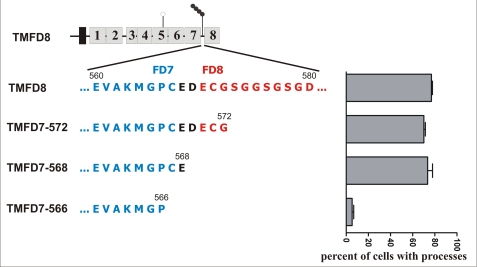FIGURE 3.
The seventh follistatin-like domain is required for process formation. To determine the role of the heparan sulfate side chains in the formation of the filopodia-like processes, the construct TMFD8 was truncated in the region between follistatin-like domain 7 (FD7; shown in blue) and 8 (FD8, shown in red). The exact amino acid sequence containing the three serine residues (serine 573, 576, and 578, respectively) used as GAG chain attachment sites of chick TM-agrin is shown on the left. The percentage of transfected cells having filopodia-like processes is shown on the right (mean ± S.E. with n = 3). Complete deletion of the GAG side-chain attachment sites did not result in a loss of the process-inducing activity (constructs TMFD7–572 and TMFD7–568), demonstrating that the GAG side chains are dispensable for process induction. In contrast, deletion of two additional amino acids (cysteine at position 567 and glutamic acid at position 568) completely abolished process-inducing activity (construct TMFD7–566).

